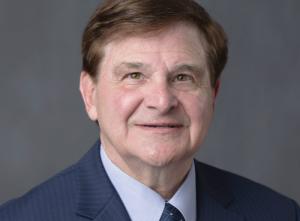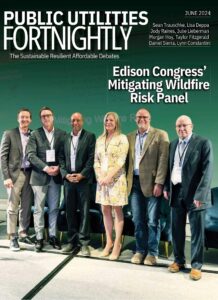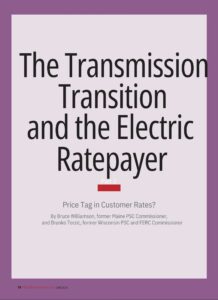Price Tag in Customer Rates?
Bruce Williamson and Branko Terzic
Fortnightly Magazine - June 2024
Part three concludes our analysis of future electric transmission requirements in the U.S. to accommodate the expected transition away from fossil fuels and to renewable and intermittent energy sources of solar and wind, all requiring a large and unprecedentedly expensive grid transformation. Our analysis draws on statements from the 2020 Princeton Net Zero (PNZ) report, which findings have found their way into official U.S. Department of Energy press announcements.
The PNZ research found that the net-zero target will require that U.S. electricity transmission systems expand “~60% by 2030 and may need to triple…by 2050” to connect wind and solar facilities to demand, tripling being a 200 increase. The PNZ cost estimates for total capital invested in transmission was “$360 billion through 2030 and $2.4 trillion by 2050.”
In part one, we reviewed the history of electric transmission expansion from 1972-2016. In part two, we provided our estimates of what investment in transmission plant would be required and the implications of that expansion for rate growth to support it and the associated operations and maintenance expenses.
We offered three observations on the consequences for ratepayers, legislators, and regulators, and for policy stability in the longer term. Here, in part three, we consider institutional consequences that could follow if indifference to ratepayer impacts takes root in FERC and federal agencies or in state legislatures and with regulators. Th ere would be institutional consequences. How these institutional consequences play out could affect policy sustain- ability and effectiveness as net-zero goals for 2050 grow nearer.
First among these is what has to be an uncomfortable middle ground occupied by incumbent utilities and independent market entrants as they face the certainty of future contests over grid-related rate increases. Th e U.S. Department of Energy is offering generous subsidies and various fast-tracking ideas to expand transmission plant in service. What utility management could resist?
In four states, legislatures have already acted as force-multipliers on federal institutional initiatives by pre-empting local authority in siting and permitting. Utilities and independents caught in the middle of this policy whirlwind may decide to invest, and if the transmission investments are considered prudently incurred, the costs could be recovered from ratepayers and earn a return for the life of the plant.
We are reminded of a kind of policy karma observable in the regulatory hearing room: what seems a win for utility management and shareholders on prudence or a rate increase may set in motion the opposition to the next permitting, utility rate case or CPCN request. With a nod to both Hegel and Sun-Tzu, the harder the push and the tactics used (thesis), the greater the resistance (antithesis), and the more effort required for resolution (synthesis) for institutions and utilities alike.
Second, for over a century, state regulators (and more recently state consumer advocates) have been re- lied upon to apply the brakes on what costs are allowed into their jurisdictional utility rate bases in order to ensure that electricity rates remained just, reasonable, and affordable.
This was the fundamental Progressive era principle followed by utility regulatory commissions throughout the United States. Simply put, the state regulatory process was expected to result in rates that were sufficient to allow the utility service provider to earn a fair return on investment and recover reasonable expense under cost-of-service regulation. At the same time, the state regulator was to guard against unjustified cost burdens and unreasonable rate increases on ratepayers of all income classes – that is, until now.
The current emphasis upon the rapid expansion of transmission and distribution facilities stands on its head the statutory function of state regulators. At the state level, prudence reviews and rate cases have had essential roles in management oversight and rate transparency, but now it is unclear what role prudence considerations will have on allowable costs when federal institutions subsidize, incentivize, and may partly own the transmission investments.
There are calls for Congress to grant fresh authority to FERC to fast track (warp speed) the permitting, siting, and construction of transmission and storage facilities within state jurisdictions. This should be cause for concern.
The backers of stronger federal institutions behind net-zero policy want a federal agency – possibly FERC, or otherwise connected with the U.S. Department of Energy – to have authority to create national energy corridors and remove siloed consideration by state authorities. State regulators and legislators are expected to fully accommodate, and not contest, the economic and physical burdens of passed-through costs and siting requirements.
Right now, states retain the responsibility for permitting intrastate electricity transmission plant, but as we noted in part two, there is precedent in interstate gas pipeline siting for FERC authority to supersede state permitting. So far, Congress has been reluctant to usurp state authority in electricity transmission line approvals.
If measures granting the FERC electricity transmission siting authority are implement- ed, they would directly challenge the present balancing of oversight institutions, together with the Constitutional authorities of state regulatory agencies and the state legislatures that created those state utility commissions well over a century ago.
Critics of the current institutional arrangement take comfort in efficiencies imagined for a centralized federal bureaucracy without evidence for it. Steps taken in that direction would seem to increase, not reduce, institutional frictions between essential state and federal functions, and increase the distance from ratepayers.
This brings us back to our initial purpose: if the state regulators and consumer advocates are muted or forced out of the picture by federal institutions, who serves and responds to the local ratepayer?
Conclusion
Like any projection, our estimates in this essay will be imperfect. We hope to provide useful context for stakeholders including ratepayers, public advocates, regulators, analysts, and those in the public who find most grid transformation studies lacking clarity regarding the ratepayer and electric customer.
Our primary purpose is to refocus attention on ratepayers and customers in the national conversation.
We began with the historical perspective on transmission development in the U.S. based on FERC Form 1. From that we constructed a high-level projection of future impacts from the transmission costs that would need to be recovered in electric rates.
For comparison purposes, we used results from the PNZ study, which projected a roughly sixty percent increase in transmission systems before 2030, and a two hundred percent increase in transmission systems before 2050. We used the PNZ results to compare with our own approach employing a simpler and transparent methodology accessible to the general public.

We will say more below on this, but utility regulators and utilities alike know that transmission plant (along with the tremendous investment in distribution circuits and battery storage required) goes into utility rate bases and is entitled to cost recovery from ratepayers as soon as plant investments are deemed "used and useful."
We should be absolutely clear: Rapid expansion of transmission plant in service and inclusion in rate base is a two-edged sword — a boon for utility earnings on rate base and profitability, but not so for ratepayers. As the character Hamlet noted, "There's the rub."
Where the additional plant and transmission structure miles will be placed is another matter. Some studies and Congressional delegates have proposed that federal authority should be used to preempt permitting and CPCN authorities of the states, similar to the authority over interstate natural gas pipelines that FERC inherited from its predecessor, the Federal Power Commission. The practical equivalence is difficult to make. Pipelines are buried. Power lines are typically not.
An easy way to contextualize how much transmission mileage will be needed can be found by comparison with the U.S. Interstate Highway system. The interstate highway system has about forty-nine thousand miles of roadway in 2020.
Plans to use Federal interstate right of way, as well as federal and state-owned land, figure prominently in approaches to siting the new transmission system, because it is obvious from this issue's Figure 1 that the scale of new transmission capacity required vastly exceeds the amount of interstate roadway available.
In addition, significant stretches of the U.S. interstate system are poor candidates for siting based on the U.S. Centers for Disease Control's Social Vulnerability Index. Already impacted or vulnerable populations would face additional risks if neighboring interstate highway were to be used for transmission infrastructure. More work needs to be done by the DOE and consultants to square this circle.
Discussion
We have three comments based on these results, following a caveat on our method. We also have two important institutional considerations, which may affect the sufficiency and sustainability of the outcome, but these will appear with concluding remarks in Part 3 in the next issue of Public Utilities Fortnightly.
The caveat relates to our use of transmission structure miles as a proxy measure of generalized transmission capacity. This might overstate how much transmission plant is required to hit the 2030 and 2050 PNZ targets, particularly if total structure miles are mostly lower voltage structure miles in local distribution circuits.
Based on Form 1 historical national average, the majority of total structure miles are in the upper subtransmission and transmission voltage ranges. That is, about eighty-two percent of structure miles are 51 kV+; sixty percent of structure miles are 72 kV+ voltages; and forty-one percent of structure miles are 132 kV+ voltages.
It is safe to say that the grid transformations required to move large amounts of electricity into lower voltage local circuits for total building and transportation electrification will depend on voltages 72 kV and above. Although there may be some loss of generality by using the total structure mile proxy in our approach, it is a good first approximation until refinements are available.
Turning back to comment on Figure 1, our first comment is that sustained growth of electrical infrastructure and its operating expense at this rate and magnitude would be unprecedented, as would be the necessary increases in the price of electricity to pay for it. With very few exceptions over several decades, electricity rate increases have not kept up with the Consumer Price Index (CPI) (Mitnick, 2024).
If our transmission cost growth approximations here are reasonable, the possible increases in electric rates might exceed the general rate of price inflation experienced by consumers. Rate growth of this magnitude is certain to be contested in state jurisdictions in rate cases and before FERC in challenges to formula rates filings where possible.
Both regulators and legislators should not forget the lessons from use of billing moratoria imposed during COVID, or the use of rate freezes for up to ten years by some states to hold off rate hikes twenty years ago. Customer bill moratoria and rate freezes postponed but did not eliminate recovery of prudently incurred costs owed to the service provider.
Moreover, ratepayers and regulators have heard for a decade that renewables and the grid transformation will bring savings and will be affordable. These expectations could become discontents merging with others related to facility permitting, fairness of cost allocations, and insufficient attention to social equity. These discontents can easily undermine commitments to long-term policy prescriptions.
Our second comment relates to unfamiliar project risk faced by financial markets. The financial markets and the rating agencies need to get it right, because the amounts involved and lingering reminders of the 2008-2009 Great Recession are not easily forgotten.
Financial markets have gotten utility markets wrong before (Enron, MCI-Worldcom). There is considerable potential for guessing wrong about future outcomes by developers and lenders, as well as the federal and state governments, because of technological complexities, regional and state differences, human behavior, and the passage of time.
Lenders who look at the risk exposure and the new opportunities created by the Inflation Reduction Act (IRA) have moved off their market optimism of early 2023 and now express caution at developments in financial markets.
To counter this, the 2023 IRA allowed DOE to serve as a transmission line "anchor customer" by taking up to fifty percent ownership in firm transmission capacity for up to forty years. This is in addition to other derisking measures to reassure financial markets, such as loan guarantees and tribal incentives for siting.
These derisking steps for financial markets are similar to the measures taken by the federal government during the 2009 GM bankruptcy, although the GM financing of thirty-three billion is a tiny fraction of the amounts required for the transmission transition discussed here. Whether and when the federal government could extract itself profitably from transmission ownership commitments like the way the Treasury Department unwound the GM stock commitment is another consideration.
Our last observation relates to the headlong pace and what may be an absence of transparency about requirements and cost. Indeed, the questions unanswered led the authors to this research.
We are faced with complex models and discussions of which model is better at one aspect or another of prediction, but there is something about the quantitative style that gives the illusion of exactitude about the future. As Vaclav Smil and many others have noted, forecasts made so far into the future are worthless.
We are making a commitment to a transmission system makeover for which no one has a very convincing grasp of the economics of implementation, deployment, and operation. As an example, cost estimates from various expert sources and sophisticated modeling tools are widely different.
This reminds the authors of the spiral or concurrent development concept sometimes used in major public acquisition programs. For example, large complex undertakings are initiated before the technology or manufacturing capability exists, in the hope these capabilities will be developed at some point after the project is underway.
As the U.S. Government Accountability Office has demonstrated in repeated studies of government procurements, these situations are recipes for cost and schedule overruns and lowered performance of the eventual product.
In the present context, one example is affordable utility-scale long-term battery storage. It is absolutely essential for a grid built around intermittent generation sources to integrate with large amounts of storage.
Affordable storage in sufficient quantity offers grid support that replaces fast ramping fossil-fueled generators and provides reliability and system resilience. The reality is that current implementations of larger scale long-term battery storage are exorbitantly expensive and lack performance except in brief intervals. Much development work remains to be done.
Supposing that affordable utility-scale storage finally arrives, it is likely that other parts of the overall transformation may already be in service. This results from the headlong pace set by the target dates with little regard for the economics or maturity of the necessary technology.
This is the risk within the false promise of spiral or concurrent development: when the needed technology or method eventually arrives, there is often wasted effort, retrofit and rework, because other systems could not be held up waiting for one or more laggard technologies or manufacturing capabilities.
Summary
To summarize Part 2, we have developed quantitative estimates of the possible transmission plant and transmission O&M that would be required to support the PNZ calculation of transmission system expansion to meet the electrification and net-zero decarbonization targets.
We acknowledge there is a possibility of overstating or understating the amount of transmission plant needed. In either case, it is our view that the projected additional investment is absolutely unprecedented and will necessarily impact ratepayers with annual or nearly annual rate adjustments. Policy instabilities could result as state and federal legislators and regulators respond to electricity bill payers unprepared for these price increases.
In Part 3 we will conclude with two important institutional concerns that may develop connected with the role of FERC and State Regulatory Commissions in the grid transformation process.
#BrankoTerzic #energy #regulations #experience #research #future #opportunity #strategy #management #people #electricity #power #utilities #future #renewables #RenewableEnergy #energysector #oilandgas #powergeneration #energyindustry #oilandgasindustry #sustainability






Pingback:Regulatory Issues in Full Electrification – Branko Terzic